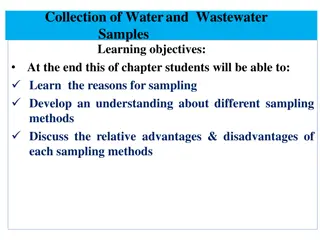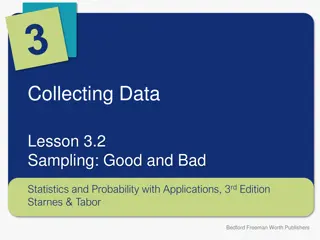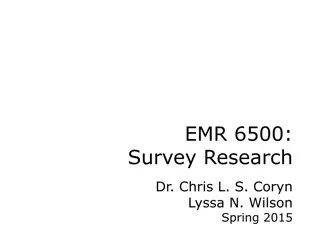Understanding Sampling in Social Research Methods
Sampling in social research involves selecting a portion of a population to draw conclusions about the entire group. It helps save time, money, and allows for accurate measurements. The key principles of sampling include systematic selection, clear definition of sample units, independence of units, consistent use of units, and avoiding biases. Sampling methods are classified as Probability and Non-Probability, depending on the research objectives. Probability sampling is used for generalizations, while Non-Probability sampling is suitable for exploratory purposes.
Download Presentation

Please find below an Image/Link to download the presentation.
The content on the website is provided AS IS for your information and personal use only. It may not be sold, licensed, or shared on other websites without obtaining consent from the author. Download presentation by click this link. If you encounter any issues during the download, it is possible that the publisher has removed the file from their server.
E N D
Presentation Transcript
B.A. IVth Semester (Elective) SOE 404 Social Research Methods Topic : Sampling
Introduction Sampling may be defined as the selection of some part of an aggregate or totality on the basis of which a judgment or inference about the aggregate or totality is made. In other words, it is the process of obtaining information about an entire population by examining only a part of it. In most of the research work and surveys, the usual approach happens to be to make generalizations or to draw inferences based on samples about the parameters of population from which the samples are taken. The researcher quite often selects only a few items from the universe for his study purposes. All this is done on the assumption that the sample data will enable him to estimate the population parameters. The items so selected constitute what is technically called a sample, their selection process or technique is called sample design and the survey conducted on the basis of sample is described as sample survey. Sample should be truly representative of population characteristics without any bias so that it may result in valid and reliable conclusions.
Need for Sampling Sampling is used in practice for a variety of reasons such as: 1. Sampling can save time and money. A sample study is usually less expensive than a census study and produces results at a relatively faster speed. 2. Sampling may enable more accurate measurements for a sample study is generally conducted by trained and experienced investigators. 3. Sampling remains the only way when population contains infinitely many members. 4. Sampling remains the only choice when a test involves the destruction of the item under study. 5. Sampling usually enables to estimate the sampling errors and, thus, assists in obtaining information concerning some characteristic of the population.
Principles of Sampling The main principle behind sampling is that we seek knowledge about the total units (called population) by observing a few units (called sample) and extend our inference about the sample to the entire population. The important principles of sampling are : 1. The sample units must be chosen in a systematic and objective manner. 2. Sample units must be clearly defined and easily identifiable. 3. Sample units must be independent of each other. 4. Same units of sample should be used throughout the study. 5. The selection process should be based on sound criteria and should avoid errors, bias and distortions.
Types of Sampling Sampling methods are classified into Probability and Non- Probability. If the purpose of research is to draw conclusions or make predictions affecting the population as a whole (as most research usually is), then one must use probability sampling. But, if one is only interested in exploring how a small group, perhaps even a representative group, is doing for purposes of illustration or explanation, then one may use non-probability sampling.
Types of Sampling Non- Probability Sampling Probability Sampling (a) Random Sampling (a) Convenience Sampling (b) Systematic Sampling (b) Judgment Sampling (c) Stratified Sampling (c) Purposive Sampling (d) Cluster Random Sampling (d) Quota Sampling (e) Snowball Sampling
Probability Sampling In probability samples, each member of the population has a known non-zero probability of being selected. The key point behind all probabilistic sampling approaches is random selection. The advantage of probability sampling is that sampling error can be calculated, which is the degree to which a sample might differ from the population. Probability method include Random Sampling, Systematic Sampling, and Stratified Sampling.
a) Random Sampling Random sampling is the purest form of probability sampling. Each member of the population has an equal and known chance of being selected. The prerequisite for a random sample is that each and every item of the universe has to be identified. Random selection is effective in a clearly defined population that is relatively small and self- contained.
b) Systematic Sampling Systematic Sampling is also called an Nth name selection technique. After the required sample size has been calculated, every Nth record is selected from a list of population members. As long as the list does not contain any hidden order, this sampling method is as good as the random sampling method. Its only advantage over the random sampling technique is simplicity. Systematic sampling is frequently used to select a specified number of records from a computer file.
c) Stratified Sampling Stratified sampling is a commonly used probability method that is superior to random sampling because it reduces the sampling error. A stratum is a subset of the population that shares at least one common characteristic. Examples of strata might be males and females, or managers and non- managers. The researcher first identifies the relevant strata and their actual representation in the population.
d) Cluster Random Sampling Cluster random sampling is useful when the population is dispersed across a wide geographic region. This method allows one to divide the population into clusters and then select the clusters at random. Thereafter one can either study all the members of the selected clusters or again take random (simple or systematic) samples of these sampled clusters. If the latter system is followed, it is called multi- stage sampling . This method, for example, could be effective to study a tribal group or a community that is dispersed . The villages could be used as clusters and can be randomly selected.
Non-Probability Sampling In non-probability sampling, members are selected from the population in some non-random manner. In this method, the degree to which the sample differs from the population remains unknown. Non-Probability methods include Convenience Sampling, Judgment Sampling, Quota Sampling and Snowball Sampling.
a) Convenience Sampling Convenience sampling is used in exploratory research where the investigator is interested in getting an inexpensive approximation of the fact. As the name implies, the sample is selected because it is convenient. Also called haphazard or accidental, this method is based on using people who are a captive audience, just happen to be walking by, or show a special interest in research. The use of volunteers is an example of convenience sampling. This method is often used during preliminary research efforts to get a gross estimate of the results, without incurring the cost or time required to select a random sample.
b) Judgment Sampling Judgment sampling is a common non-probability method. The researcher selects the sample based on judgment. This is usually an extension of convenience sampling. For example, a researcher may decide to draw the entire sample from one 'representative village, even though the population may be distributed over a number of villages. When using this method, the researcher 'feels that the chosen sample is representative of the entire population.
c) Purposive Sampling Purposive sampling, much similar to judgment sampling, is where the researcher targets a group of people believed to be typical or average, or a group specially picked for some unique purpose. The researcher never knows if the sample is representative of the population, and this method is largely limited to exploratory research.
d) Quota Sampling Quota sampling is the non-probability equivalent of stratified sampling. Like stratified sampling, the researcher first identifies the strata and their proportions in the population. Then convenience or judgment sampling is used to select the required number of subjects from each stratum. The researcher resorts to haphazard or accidental sampling, and makes no effort to contact people who are difficult to reach. This differs from stratified sampling, where the strata are filled by random sampling.
e) Snowball Sampling Snowball sampling is a special non-probability method used when the desired sample characteristic is rare. It may be extremely difficult or cost prohibitive to locate respondents in these situations. Snowball sampling relies on referrals from initial subjects to generate additional subjects. In other words, snowball sampling comprises identification of respondents who in turn refer researches to other respondents. For example, an investigator finds a rare genetic trait in a person, and starts tracing his pedigree to understand the origin, inheritance and etiology of the disease.
Suggested Reading 1. Ahuja, Ram, 2013, Research Methods, Rawat Publications, New Delhi. 2. Kothari, C.R., 2013, Research Methodology: Methods and Techniques (Second Revised International (P) Limited Publishers, New Delhi. 3. Young, P. V., 1988, Scientific Social Surveys and Research, Prentice Hall, New Delhi. 4. Babbie, E., 1989, The Practice of Social Research, Wadsworth Publishing Company, Belmont, California. Edition), New Age























